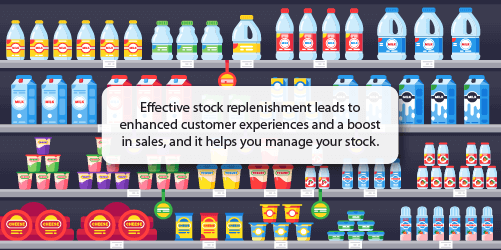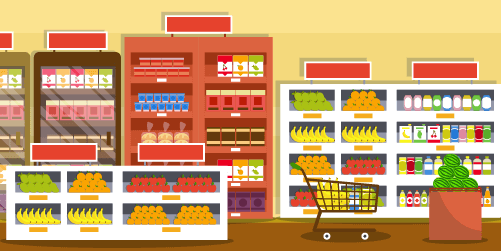Imagine this: a customer visits your store for a specific product. When they get there, they can’t find the product anywhere. Naturally, they try their luck and ask the sales assistant if there is one in the back room. Only to get the answer; “Sorry, they all sold out yesterday.” Frustrating right?

That's what can happen if you fail to replenish your store correctly. It's also why stock replenishment plays a critical role in any retail environment. Yet, many can still overlook it. If done correctly, it enhances the customer experience, boosts your sales, and helps you to manage your stock.
For any new retailer, it's a process that can appear daunting. But it doesn't need to be. If you're a new retailer or want a few extra tips to help you, you'll find them in this article.

1. Ensure you understand your store layout
Our first tip doesn't apply to your products or your shelf plans but to your floor plan. And there is a good reason for this. Planograms and floor plans are intrinsically linked.
By having a good understanding of your store layout from a floor planning point of view, you can calculate the necessary space needed for your categories. It also allows you to have the correct product ranges in your store.

Understanding your categories at a macro level also allows you to manage your product groupings at a micro level.
What happens if you fail to do this? Simple.
- Overstocking or over-ranging your categories. That means you will have stock in the backroom that is not moving.
- Understocking on items. This can lead to empty shelves and give your customers the idea that you don't have what they want.
The goal is to ensure customers return to your store. By ordering too much or not enough stock, you’re not giving your customers any reasons to want to shop at your store.

2. Ensure you have the correct space allocation for your categories
Having the correct space allocated to each of your categories will help ensure that all of your products in the various categories sell out at an even rate.
For example, if you’re using specialist space or floor planning software, you can use heat maps to indicate days of supply and unit movement.
When your products sell out at an even rate, it is easier for you to plan for stock replenishment.
It will also help you with any resource management. Instead of your merchandiser restocking one or two categories multiple times in a short period, and often out of order, they can focus on restocking categories as planned. Or clean up messy shelves.
We also recommend that once your store is operational, you look at your sales and unit data to ensure that you achieve even days of supply across categories since that will help you plan stock orders.
Failing to allocate the correct space to categories can lead to the following.
- Over- or understocking in some categories
It can lead to some product groupings selling out faster than others, meaning you will have to spend more time restocking your shelves than you should.
- Incorrect space allocation, which harms the shopper experience
If you don't allocate the correct space to your fast-moving products, they will sell out faster, which leads to customers not finding what they want. That erodes any trust you may have built up with them.
Meanwhile, your slow movers could take up more space than they deserve - space that should have gone to your popular products.

3. Ensure you have a detailed display hierarchy (CDT)
A display hierarchy or consumer decision tree (CDT) is a critical element to include when building out any category. Why?
For one, it helps you think like a customer and learn how they make buying decisions when they’re standing in front of your shelves. A CDT can help you understand how a product range performs as it allows you to get in-depth insights into the different levels of your category, such as at a segment or brand level.

It also minimises the chances of you misinterpreting your range data. A typical example here is giving too much space to a category because of one product that performs well.
As for the consequences of not having a detailed display hierarchy, they are twofold:
- You won’t understand how your customers shop in your store
Instead of looking at your product groupings to see how they perform, you’ll have a list of products. That makes any data analysis difficult.
- You can end up with too little stock and empty shelves or too much and not enough space
When it comes to knowing how much stock to order, it’ll be difficult, if not impossible, to do that accurately.

4. Build data-driven planograms
Planograms are essential in providing a detailed micro-level view of your category. When building any planogram, we recommend using sales and unit data to balance out your days of supply for all categories across your store.
In doing that, you can better manage your stock and not need to replenish your shelves too often. The converse is also true. If you fail to use data, while you can still build a planogram, it will be guesswork.
What is on your planogram (and shelf) will not reflect buying behaviours.
You'll find your products selling out faster than expected, leaving you with empty shelves. Products that perform well might have fewer facings than they deserve. Then your slow-moving products will receive more space, which results in the unwanted creation of cold spots.
We wrote about how effective stock management relies on data-driven planograms. In that piece, we focus on how you use planograms, which dovetail with what's written in this article.

5. Implement your planograms correctly (and get feedback)
After building your data-driven planogram, the next step is accurate implementation in-store. After all, you can build the best planogram possible and populate it with all the relevant data.
But it won't mean much if you don't implement the planogram correctly in-store.

When you correctly implement a data-driven planogram, you can:
- Track and collect valuable data on all product sales. With this data, you can identify your fast- and slow-moving products;
- Prevent any overstock issues; and
- Manage your stock orders for all of your categories. It will also help you to make future placement decisions when doing a planogram refresh.
If you’re looking for tips on what to do before implementing your planograms, we recommend you request the correct drop count per category. That’s especially true if you’re using a third party to assist you with building your planograms.
Also, you must have your stock ready for implementation, which includes having enough to follow the planograms.
Besides implementing your planograms, you also need to get feedback. With this feedback, you can learn if the planogram is working or if you need to adjust your approach. With proper feedback, you also have the opportunity to innovate and try new ideas.

6. Monitor and tweak your planograms and floor plans (if necessary)
Building and implementing data-driven planograms are critical as already mentioned. But it’s also crucial to monitor these planograms.
That’s because of a few reasons, which we'll pose as questions.
- Does the implemented planogram lead to an increase in sales?
It’s often the case that once you implement a planogram built using all the correct data, you can see an uptick in sales. That is, of course, if you implement it as suggested with all the facings and space per product.
- Are there any potential post-implementation problems?
By monitoring the category post-implementation, you can quickly spot if there are any problems. For example, are your products selling as much as expected? If not, then you need to consider changing the shelf space.
- Are there any opportunity gaps?
With increased sales growth, you might find that some products sell even more than you had anticipated.
With all this knowledge, you can ensure that you adjust your replenishment cycle where necessary. You can also note when to restock your shelves to ensure no empty spaces.
Without monitoring your planograms, there is a good chance you’ll find yourself struggling with multiple problems. That could include, amongst others, missing opportunity gaps, losing sales and creating an unpleasant shopping experience for your customers.

Conclusion
Replenishing your shelves appropriately and on time can go a long way to helping you meet customer demand. That’s especially important if you’re a new retailer.
Are you looking for assistance to improve your stock replenishment cycles? Or are you looking for help building data-driven planograms for your retail business? Either way, DotActiv can help. You can book a complimentary custom exploratory consultation with us here or browse our software and services on our online store.


